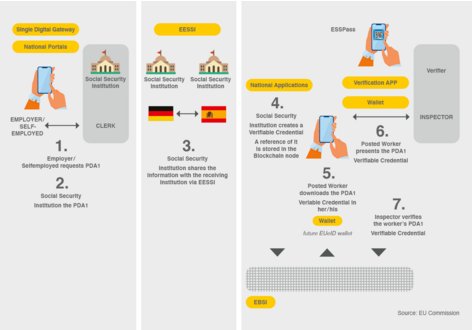1. Communications between social security institutions
Through EESSI (European Exchange of Social Security Information), the EC wants to digitise and simplify data exchanging between social security institutions in the EU and the EFTA states (Iceland, Liechtenstein, Norway, and Switzerland) and the United Kingdom.
ed* Nr. 03/2021 – Chapter 3
EESSI should enable faster, paperless, and more efficient data exchanging between different social security institutions and with national authorities, e.g. the data needed to issue a PDA1 certificate. Individual cases and inquiries from insured people will be processed more quickly and the duration, i.e., calculating and paying the benefits, will be shortened. Standardised electronic procedures will help to ensure that the social security coordination regulations are applied correctly. Special precautions will ensure that the exchanged data is both correct and complete.
Every beginning is difficult ...
The “history” of EESSI goes back a long way. It is one of the most comprehensive and exacting projects regarding the digitisation of social security systems. Whereas the transition from a paper-based to an electronic data exchanging system was originally – and very optimistically – planned for a period up to April 30, 2012, this was “flexibly” extended by resolution E4 from the Administrative Commission for the Coordination of Social Security Systems.1 The transition should take place within two years from the day the central EESSI system was developed, tested and made available for use so that the participating countries could start integrating themselves into the central system. This deadline ended on July 2, 2019 and ultimately it could not be met.
Digitalising the coordination of social security systems: how it all comes together

According to the EC, as of October 2021, most participating countries – a total of around 3,000 social security organisations – are at least partially connected to EESSI and able to exchange data. Only nine member states, including Bulgaria, Cyprus, Estonia, Croatia, Ireland, Latvia, Malta, Slovenia as well as and despite leaving the EU, the United Kingdom, are fully connected and use EESSI for all of their applications. Full inter-connectability by all participating countries is expected by mid-2023.
.... and there will still be stumbling blocks even then
In order to process data accordingly during electronic exchanging and to communicate with one another, the EC initially made their key software RINA available to the social security institutions. Thanks to RINA (Reference Implementation for a National Application), the responsible social security authorities in the European Economic Area countries, the United Kingdom and Switzerland have been given a temporary instrument by the EC that will gradually introduce electronic communications with one another. RINA is used by the majority of participating institutions and is one of the central components of EESSI, which is currently still being supported by the EC.
Last year, the EC decided to stop supporting and maintaining RINA itself and announced that this task would be handed over to its member states by the end of 20212. Since then, the social security institutions in Europe have been trying to find solutions in order to be able to continue communicating smoothly. Some – including the social security institutions in Germany – have developed their own software to replace RINA, either partially or completely. Others are participating in a joint public procurement to find a new provider for RINA.
An “early” handover could cause problems especially for small social security organisations. This is all the more relevant as a joint European procurement procedure for further technical support that involves the participating countries that use the RINA software would probably not be completed before the end of 2022.
The advantages outweigh the effort
Even if the effort made by the social security institutions was and, in some cases, still is huge, the benefits of electronic data exchanging outweigh the disadvantages in a digitised world with mobile EU citizens. This will contribute to optimised case processing, relieve the burden on social insurance institution staff and increase the data quality. Transfer errors will be avoided, and the security precautions implemented regarding the exchanged data will help to combat errors. Standardised electronic documents translated into the relevant languages will also simplify multilingual communications. EU citizens will also benefit from less time-consuming and error-prone electronic data exchanges.


